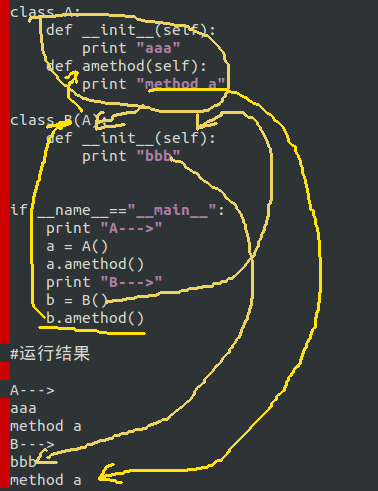
在上一讲代码的基础上,做进一步修改,成为了如下程序,请看官研习这个程序:
class Person:
def __init__(self, name, email):
self.name = name
self.email = email
class Programmer(Person):
def __init__(self, name,email,lang, system, website):
Person.__init__(self,name,email)
self.lang = lang
self.system = system
self.website = website
class Pythoner(Programmer):
def __init__(self,name,email):
Programmer.__init__(self,name,email,"python","Ubuntu","qiwsir.github.io")
if __name__=="__main__":
writer = Pythoner("qiwsir","qiwsir@gmail.com")
print "name=",writer.name
print "lang=",writer.lang
print "email=",writer.email
print "system=",writer.system
print "website=",writer.website
#运行结果
name= qiwsir
lang= python
email= qiwsir@gmail.com
system= Ubuntu
website= qiwsir.github.io
对结果很满意,再看程序中的继承关系:Pythoner
为了能够突出继承问题的探究,还是用那种简单的类来做实验。
多余的B
class A:
def __init__(self):
print "aaa"
class B(A):
pass
if __name__=="__main__":
a = A()
b = B()
#运行结果
aaa
aaa
B继承A,没有任何修改地继承,B就可以不用写任何东西了,或者说B本质上就是一个多余。在真实的编程过程中,没有这样写的,这里仅仅是为了向看官展示一下继承的含义罢了。
#!/usr/bin/env python
#coding:utf-8
class A:
def __init__(self):
print "aaa"
class B:
def __init__(self):
print "bbb"
class C1(A,B):
pass
class C2(B,A):
pass
if __name__=="__main__":
print "A--->",
a = A()
print "B--->",
b = B()
print "C1(A,B)--->",
c1 = C1()
print "C2(B,A)--->",
c2 = C2()
#运行结果
A---> aaa
B---> bbb
C1(A,B)---> aaa
C2(B,A)---> bbb
列位看官是否注意了,类C1继承了两个类A,B;类C2也继承了两个类,只不过书写顺序有点区别(B,A)。从运行结果可以看出,当子类继承多个父类的时候,对于构造函数__init__(),只有第一个能够被继承,第二个就等掉了。所以,一般情况下,不会在程序中做关于构造函数的同时多个继承,不过可以接力继承,就如同前面那个比较真实的代码一样。
其它方法的继承
class A:
def __init__(self):
print "aaa"
def amethod(self):
print "method a"
class B(A):
def __init__(self):
print "bbb"
if __name__=="__main__":
print "A--->"
a = A()
a.amethod()
print "B--->"
b = B()
b.amethod()
#运行结果
A--->
aaa
method a
B--->
bbb
method a
为了说明白上面的情况,还是画了一张图,不过,我画完之后,就后悔了,看这张图好像更糊涂了。怎么着也画了,还是贴出来,如果能够协助理解更好了。

A的实例和调用,就不多说了。重点看B,类B继承了A,同时,B在构造函数中自己做了规定,也就是B的构造函数是按照B的意愿执行,不执行A的内容,但是,A还有一个amethod(self)方法,B则继承了这个方法。当通过类B的实例调用这个方法的时候,就能够成功了:b.amethod()
这就是方法的继承和调用方法。
所谓继承,就是从下到上一级一级地找相应的继承对象,找到了就继承之。如果有同名的怎么办?按照什么顺序找呢?
应用网上的一段:
在Python中,可以進行多重繼承,這個時候要注意搜尋的順序,是從子類別開始,接著是同一階層父類別由左至右搜尋,再至更上層同一階層父類別由左至右搜尋,直到達到頂層為止。
代码举例:
def method2(self):
print('A.method2')
class B(A):
def method3(self):
print('B.method3')
class C(A):
def method2(self):
print('C.method2')
def method3(self):
print('C.method3')
class D(B, C):
def method4(self):
print('C.method4')
d = D()
d.method4() # 在 D 找到,C.method4
d.method3() # 以 D->B 順序找到,B.method3
d.method2() # 以 D->B->C 順序找到,C.method2
d.method1() # 以 D->B->C->A 順序找到,A.method1
务必请真正的学习者要对照每个类的每个方法,依次找到相应的输出结果。从而理解继承的顺序。学习,就要点滴积累。




